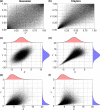Circular-linear copulae for animal movement data
- PMID: 35915739
- PMCID: PMC9314651
- DOI: 10.1111/2041-210X.13821
Circular-linear copulae for animal movement data
Abstract
Animal movement is often modelled in discrete time, formulated in terms of steps taken between successive locations at regular time intervals. Steps are characterized by the distance between successive locations (step lengths) and changes in direction (turn angles). Animals commonly exhibit a mix of directed movements with large step lengths and turn angles near 0 when travelling between habitat patches and more wandering movements with small step lengths and uniform turn angles when foraging. Thus, step lengths and turn angles will typically be cross-correlated.Most models of animal movement assume that step lengths and turn angles are independent, likely due to a lack of available alternatives. Here, we show how the method of copulae can be used to fit multivariate distributions that allow for correlated step lengths and turn angles.We describe several newly developed copulae appropriate for modelling animal movement data and fit these distributions to data collected on fishers (Pekania pennanti). The copulae are able to capture the inherent correlation in the data and provide a better fit than a model that assumes independence. Further, we demonstrate via simulation that this correlation can impact movement patterns (e.g. rates of dispersion overtime).We see many opportunities to extend this framework (e.g. to consider autocorrelation in step attributes) and to integrate it into existing frameworks for modelling animal movement and habitat selection. For example, copulae could be used to more accurately sample available locations when conducting habitat-selection analyses.
© 2022 The Authors. Methods in Ecology and Evolution published by John Wiley & Sons Ltd on behalf of British Ecological Society.
Conflict of interest statement
None.
Figures






Similar articles
-
Animal movement tools (amt): R package for managing tracking data and conducting habitat selection analyses.Ecol Evol. 2019 Feb 5;9(2):880-890. doi: 10.1002/ece3.4823. eCollection 2019 Jan. Ecol Evol. 2019. PMID: 30766677 Free PMC article.
-
Fishers (Pekania pennanti) are forest structure specialists when resting and generalists when moving: behavior influences resource selection in a northern Rocky Mountain fisher population.Mov Ecol. 2024 Jul 6;12(1):49. doi: 10.1186/s40462-024-00487-5. Mov Ecol. 2024. PMID: 38971747 Free PMC article.
-
Identifying resting locations of a small elusive forest carnivore using a two-stage model accounting for GPS measurement error and hidden behavioral states.Mov Ecol. 2021 Apr 6;9(1):17. doi: 10.1186/s40462-021-00256-8. Mov Ecol. 2021. PMID: 33823940 Free PMC article.
-
Correlation and studies of habitat selection: problem, red herring or opportunity?Philos Trans R Soc Lond B Biol Sci. 2010 Jul 27;365(1550):2233-44. doi: 10.1098/rstb.2010.0079. Philos Trans R Soc Lond B Biol Sci. 2010. PMID: 20566500 Free PMC article. Review.
-
Applications of step-selection functions in ecology and conservation.Mov Ecol. 2014 Feb 7;2(1):4. doi: 10.1186/2051-3933-2-4. eCollection 2014. Mov Ecol. 2014. PMID: 25520815 Free PMC article. Review.
Cited by
-
Simultaneous estimation of the temporal and spatial extent of animal migration using step lengths and turning angles.Mov Ecol. 2024 Jan 8;12(1):1. doi: 10.1186/s40462-023-00444-8. Mov Ecol. 2024. PMID: 38191509 Free PMC article.
-
Using pseudo-absence models to test for environmental selection in marine movement ecology: the importance of sample size and selection strength.Mov Ecol. 2022 Dec 29;10(1):60. doi: 10.1186/s40462-022-00362-1. Mov Ecol. 2022. PMID: 36581885 Free PMC article.
-
A three-step approach for assessing landscape connectivity via simulated dispersal: African wild dog case study.Landsc Ecol. 2023;38(4):981-998. doi: 10.1007/s10980-023-01602-4. Epub 2023 Feb 17. Landsc Ecol. 2023. PMID: 36941928 Free PMC article.
-
An introduction to statistical models used to characterize species-habitat associations with animal movement data.Mov Ecol. 2025 Apr 17;13(1):27. doi: 10.1186/s40462-025-00549-2. Mov Ecol. 2025. PMID: 40247418 Free PMC article. Review.
References
-
- Alfonsi, A. , & Jourdain, B. (2014). A remark on the optimal transport between two probability measures sharing the same copula. Statistics and Probability Letters, 84, 131–134.
-
- Avgar, T. , Potts, J. R. , Lewis, M. A. , & Boyce, M. S. (2016). Integrated step selection analysis: Bridging the gap between resource selection and animal movement. Methods in Ecology and Evolution, 7, 619–630.
-
- Benth, F. E. , Di Nunno, G. , & Schroers, D. (2021). Copula measures and Sklar's theorem in arbitrary dimensions. Scandinavian Journal of Statistics, 1–40. 10.1111/sjos.12559 - DOI
-
- Brown, D. D. , LaPoint, S. , Kays, R. , Heidrich, W. , Kümmeth, F. , & Wikelski, M. (2012). Accelerometer‐informed GPS telemetry: Reducing the trade‐off between resolution and longevity. Wildlife Society Bulletin, 36, 139–146. 10.1002/wsb.111 - DOI
-
- Calabrese, J. M. , Fleming, C. H. , & Gurarie, E. (2016). Ctmm: An R package for analyzing animal relocation data as a continuous‐time stochastic process. Methods in Ecology and Evolution, 7, 1124–1132.
LinkOut - more resources
Full Text Sources
